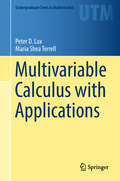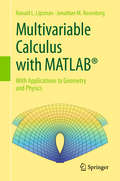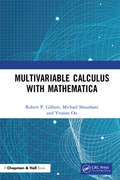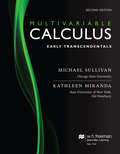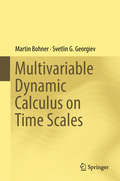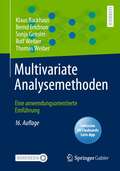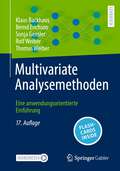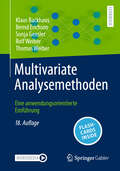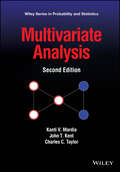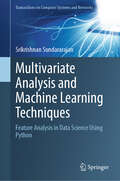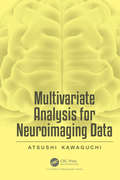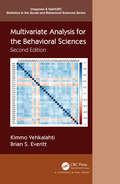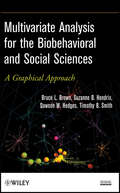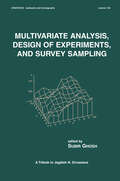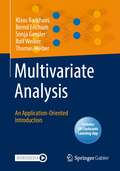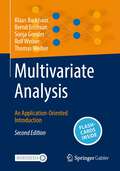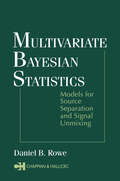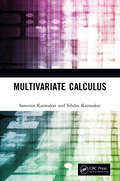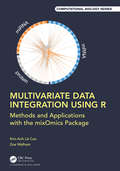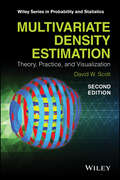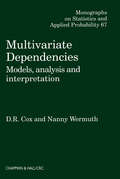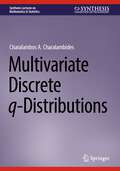- Table View
- List View
Multivariable Calculus with Applications (Undergraduate Texts In Mathematics)
by Peter D. Lax Maria Shea TerrellThis text in multivariable calculus fosters comprehension through meaningful explanations. Written with students in mathematics, the physical sciences, and engineering in mind, it extends concepts from single variable calculus such as derivative, integral, and important theorems to partial derivatives, multiple integrals, Stokes’ and divergence theorems. Students with a background in single variable calculus are guided through a variety of problem solving techniques and practice problems. Examples from the physical sciences are utilized to highlight the essential relationship between calculus and modern science. The symbiotic relationship between science and mathematics is shown by deriving and discussing several conservation laws, and vector calculus is utilized to describe a number of physical theories via partial differential equations. Students will learn that mathematics is the language that enables scientific ideas to be precisely formulated and that science is a source for the development of mathematics.
Multivariable Calculus with MATLAB®
by Ronald L. Lipsman Jonathan M. RosenbergThis comprehensive treatment of multivariable calculus focuses on the numerous tools that MATLAB#65533; brings to the subject, as it presents introductions to geometry, mathematical physics, and kinematics. Covering simple calculations with MATLAB#65533;, relevant plots, integration, and optimization, the numerous problem sets encourage practice with newly learned skills that cultivate the reader's understanding of the material. Significant examples illustrate each topic, and fundamental physical applications such as Kepler's Law, electromagnetism, fluid flow, and energy estimation are brought to prominent position. Perfect for use as a supplement to any standard multivariable calculus text, a "mathematical methods in physics or engineering" class, for independent study, or even as the class text in an "honors" multivariable calculus course, this textbook will appeal to mathematics, engineering, and physical science students. MATLAB#65533; is tightly integrated into every portion of this book, and its graphical capabilities are used to present vibrant pictures of curves and surfaces. Readers benefit from the deep connections made between mathematics and science while learning more about the intrinsic geometry of curves and surfaces. With serious yet elementary explanation of various numerical algorithms, this textbook enlivens the teaching of multivariable calculus and mathematical methods courses for scientists and engineers.
Multivariable Calculus with Mathematica
by Robert P. Gilbert Michael Shoushani Yvonne OuMultivariable Calculus with Mathematica is a textbook addressing the calculus of several variables. Instead of just using Mathematica to directly solve problems, the students are encouraged to learn the syntax and to write their own code to solve problems. This not only encourages scientific computing skills but at the same time stresses the complete understanding of the mathematics. Questions are provided at the end of the chapters to test the student’s theoretical understanding of the mathematics, and there are also computer algebra questions which test the student’s ability to apply their knowledge in non-trivial ways. Features Ensures that students are not just using the package to directly solve problems, but learning the syntax to write their own code to solve problems Suitable as a main textbook for a Calculus III course, and as a supplementary text for topics scientific computing, engineering, and mathematical physics Written in a style that engages the students’ interest and encourages the understanding of the mathematical ideas
Multivariable Calculus: Early Transcendentals
by Michael Sullivan Kathleen MirandaMichael Sullivan and Kathleen Miranda have written a contemporary calculus textbook that instructors will respect and students can use. Consistent in its use of language and notation, Sullivan/Miranda’s Calculus offers clear and precise mathematics at an appropriate level of rigor. The authors help students learn calculus conceptually, while also emphasizing computational and problem-solving skills. The book contains a wide array of problems including engaging challenge problems and applied exercises that model the physical sciences, life sciences, economics, and other disciplines. Algebra-weak students will benefit from marginal annotations that help strengthen algebraic understanding, the many references to review material, and extensive practice exercises. Strong media offerings include interactive figures and online homework. Sullivan/Miranda’s Calculus has been built with today’s instructors and students in mind.
Multivariable Dynamic Calculus on Time Scales
by Svetlin G. Georgiev Martin BohnerThis book offers the reader an overview of recent developments of multivariable dynamic calculus on time scales, taking readers beyond the traditional calculus texts. Covering topics from parameter-dependent integrals to partial differentiation on time scales, the book's nine pedagogically oriented chapters provide a pathway to this active area of research that will appeal to students and researchers in mathematics and the physical sciences. The authors present a clear and well-organized treatment of the concept behind the mathematics and solution techniques, including many practical examples and exercises.
Multivariate Analysemethoden: Eine anwendungsorientierte Einführung
by Klaus Backhaus Rolf Weiber Bernd Erichson Thomas Weiber Sonja GenslerWir leben in einer Welt der Daten. Daten allein aber sind wertlos, wenn wir nicht in der Lage sind, aus ihnen Informationen zu gewinnen. Um Informationen aus Daten zu extrahieren, sind Methoden der multivariaten Datenanalyse unerlässlich.Dieses Buch bietet eine leicht verständliche Einführung in die wichtigsten Methoden der multivariaten Datenanalyse. Es ist anwendungsorientiert, erfordert nur wenige Kenntnisse in Mathematik und Statistik, demonstriert die Verfahren mit numerischen Beispielen und veranschaulicht jede Methode anhand eines ausführlichen Fallbeispiels. Für Interessierte werden im Einführungskapitel für alle Verfahren relevante statistische Grundlagen aufgefrischt. Für die 16. Auflage wurden alle Kapitel inkl. Fallbeispielen neu gefasst und mit der aktuellen Version von IBM SPSS gerechnet. Neue, für die anwendungsorientierten Nutzer sinnvolle Auswertungsoptionen wurden ergänzt.Der InhaltEinführung in die empirische Datenanalyse – Regressionsanalyse – VarianzanalyseDiskriminanzanalyse – Logistische Regression – Kontingenzanalyse – FaktorenanalyseClusteranalyse – Conjoint-AnalyseDas Buch wurde 2015 vom Berufsverband Deutscher Markt- und Sozialforscher (BVM) als das Lehrbuch ausgezeichnet, das die deutsche Marktforschungspraxis in den letzten Jahrzehnten nachhaltig geprägt hat. Es ist auch in Englisch und Chinesisch erschienen.Auf der Webseite www.multivariate-methods.info werden weitere Materialien (bspw. Excel-Beispiele, R Code) angeboten, durch die sich die Verfahren noch besser erschließen und vertiefen lassen. Interaktive Flashcards helfen den eigenen Lernfortschritt zu kontrollieren. Mit der Springer Nature Flashcards-App können Sie exklusive Inhalte nutzen und Ihr Wissen testen.
Multivariate Analysemethoden: Eine anwendungsorientierte Einführung
by Klaus Backhaus Rolf Weiber Bernd Erichson Thomas Weiber Sonja GenslerWir leben in einer Welt der Daten. Daten allein aber sind wertlos, wenn wir nicht in der Lage sind, aus ihnen Informationen zu gewinnen. Um Informationen aus Daten zu extrahieren, sind Methoden der multivariaten Datenanalyse unerlässlich.Dieses Buch bietet eine leicht verständliche Einführung in die wichtigsten Methoden der multivariaten Datenanalyse. Es ist anwendungsorientiert, erfordert nur wenige Kenntnisse in Mathematik und Statistik, demonstriert die Verfahren mit numerischen Beispielen und veranschaulicht jede Methode anhand eines ausführlichen Fallbeispiels. Für Interessierte werden im Einführungskapitel für alle Verfahren relevante statistische Grundlagen aufgefrischt. Für die 17. Auflage wurden alle Kapitel überprüft und mit der aktuellen Version von IBM SPSS gerechnet.Der InhaltEinführung in die empirische Datenanalyse – Regressionsanalyse – Varianzanalyse – Diskriminanzanalyse – Logistische Regression – Kontingenzanalyse – Faktorenanalyse – Clusteranalyse – Conjoint-AnalyseDas Buch wurde 2015 vom Berufsverband Deutscher Markt- und Sozialforscher (BVM) als das Lehrbuch ausgezeichnet, das die deutsche Marktforschungspraxis in den letzten Jahrzehnten nachhaltig geprägt hat. Es ist auch in Englisch und Chinesisch erschienen.Auf der Webseite www.multivariate-methods.info werden weitere Materialien (bspw. Excel-Beispiele, R Code) angeboten, durch die sich die Verfahren noch besser erschließen und vertiefen lassen. Interaktive Flashcards helfen den eigenen Lernfortschritt zu kontrollieren. Mit der Springer Nature Flashcards-App können Sie exklusive Inhalte nutzen und Ihr Wissen testen.
Multivariate Analysemethoden: Eine anwendungsorientierte Einführung
by Klaus Backhaus Rolf Weiber Bernd Erichson Thomas Weiber Sonja GenslerWir leben in einer Welt der Daten. Daten allein aber sind wertlos, wenn wir nicht in der Lage sind, aus ihnen Informationen zu gewinnen. Um Informationen aus Daten zu extrahieren, sind Methoden der multivariaten Datenanalyse unerlässlich. Dieses Buch bietet eine leicht verständliche Einführung in die wichtigsten Methoden der multivariaten Datenanalyse. Es ist anwendungsorientiert, erfordert nur wenige Kenntnisse in Mathematik und Statistik, demonstriert die Verfahren mit numerischen Beispielen und veranschaulicht jede Methode anhand eines ausführlichen Fallbeispiels. Für Interessierte werden im Einführungskapitel für alle Verfahren relevante statistische Grundlagen aufgefrischt. Für die 18. Auflage wurden alle Kapitel überprüft und mit der aktuellen Version von IBM SPSS gerechnet. Der Inhalt Einführung in die empirische Datenanalyse – Regressionsanalyse – Varianzanalyse – Diskriminanzanalyse – Logistische Regression – Kontingenzanalyse – Faktorenanalyse – Clusteranalyse – Conjoint-Analyse Das Buch wurde 2015 vom Berufsverband Deutscher Markt- und Sozialforscher (BVM) als das Lehrbuch ausgezeichnet, das die deutsche Marktforschungspraxis in den letzten Jahrzehnten nachhaltig geprägt hat. Es ist auch in Englisch und Chinesisch erschienen. Auf der Webseite www.multivariate-methods.info werden weitere Materialien (bspw. Excel-Beispiele, R Code) angeboten, durch die sich die Verfahren noch besser erschließen und vertiefen lassen. Interaktive Flashcards helfen den eigenen Lernfortschritt zu kontrollieren. Mit der Springer Nature Flashcards-App können Sie exklusive Inhalte nutzen und Ihr Wissen testen.
Multivariate Analysis (Wiley Series in Probability and Statistics)
by Kanti V. Mardia John T. Kent Charles C. TaylorMultivariate Analysis Comprehensive Reference Work on Multivariate Analysis and its Applications The first edition of this book, by Mardia, Kent and Bibby, has been used globally for over 40 years. This second edition brings many topics up to date, with a special emphasis on recent developments. A wide range of material in multivariate analysis is covered, including the classical themes of multivariate normal theory, multivariate regression, inference, multidimensional scaling, factor analysis, cluster analysis and principal component analysis. The book also now covers modern developments such as graphical models, robust estimation, statistical learning, and high-dimensional methods. The book expertly blends theory and application, providing numerous worked examples and exercises at the end of each chapter. The reader is assumed to have a basic knowledge of mathematical statistics at an undergraduate level together with an elementary understanding of linear algebra. There are appendices which provide a background in matrix algebra, a summary of univariate statistics, a collection of statistical tables and a discussion of computational aspects. The work includes coverage of: Basic properties of random vectors, copulas, normal distribution theory, and estimation Hypothesis testing, multivariate regression, and analysis of variance Principal component analysis, factor analysis, and canonical correlation analysis Discriminant analysis, cluster analysis, and multidimensional scaling New advances and techniques, including supervised and unsupervised statistical learning, graphical models and regularization methods for high-dimensional data Although primarily designed as a textbook for final year undergraduates and postgraduate students in mathematics and statistics, the book will also be of interest to research workers and applied scientists.
Multivariate Analysis and Machine Learning Techniques: Feature Analysis in Data Science Using Python (Transactions on Computer Systems and Networks)
by Srikrishnan SundararajanThis book offers a comprehensive first-level introduction to data analytics. The book covers multivariate analysis, AI / ML, and other computational techniques for solving data analytics problems using Python. The topics covered include (a) a working introduction to programming with Python for data analytics, (b) an overview of statistical techniques – probability and statistics, hypothesis testing, correlation and regression, factor analysis, classification (logistic regression, linear discriminant analysis, decision tree, support vector machines, and other methods), various clustering techniques, and survival analysis, (c) introduction to general computational techniques such as market basket analysis, and social network analysis, and (d) machine learning and deep learning. Many academic textbooks are available for teaching statistical applications using R, SAS, and SPSS. However, there is a dearth of textbooks that provide a comprehensiveintroduction to the emerging and powerful Python ecosystem, which is pervasive in data science and machine learning applications. The book offers a judicious mix of theory and practice, reinforced by over 100 tutorials coded in the Python programming language. The book provides worked-out examples that conceptualize real-world problems using data curated from public domain datasets. It is designed to benefit any data science aspirant, who has a basic (higher secondary school level) understanding of programming and statistics. The book may be used by analytics students for courses on statistics, multivariate analysis, machine learning, deep learning, data mining, and business analytics. It can be also used as a reference book by data analytics professionals.
Multivariate Analysis for Neuroimaging Data
by Atsushi KawaguchiThis book describes methods for statistical brain imaging data analysis from both the perspective of methodology and from the standpoint of application for software implementation in neuroscience research. These include those both commonly used (traditional established) and state of the art methods. The former is easier to do due to the availability of appropriate software. To understand the methods it is necessary to have some mathematical knowledge which is explained in the book with the help of figures and descriptions of the theory behind the software. In addition, the book includes numerical examples to guide readers on the working of existing popular software. The use of mathematics is reduced and simplified for non-experts using established methods, which also helps in avoiding mistakes in application and interpretation. Finally, the book enables the reader to understand and conceptualize the overall flow of brain imaging data analysis, particularly for statisticians and data-scientists unfamiliar with this area. The state of the art method described in the book has a multivariate approach developed by the authors’ team. Since brain imaging data, generally, has a highly correlated and complex structure with large amounts of data, categorized into big data, the multivariate approach can be used as dimension reduction by following the application of statistical methods. The R package for most of the methods described is provided in the book. Understanding the background theory is helpful in implementing the software for original and creative applications and for an unbiased interpretation of the output. The book also explains new methods in a conceptual manner. These methodologies and packages are commonly applied in life science data analysis. Advanced methods to obtain novel insights are introduced, thereby encouraging the development of new methods and applications for research into medicine as a neuroscience.
Multivariate Analysis for the Behavioral Sciences, Second Edition (Chapman & Hall/CRC Statistics in the Social and Behavioral Sciences)
by Brian S. Everitt Kimmo VehkalahtiMultivariate Analysis for the Behavioral Sciences, Second Edition is designed to show how a variety of statistical methods can be used to analyse data collected by psychologists and other behavioral scientists. Assuming some familiarity with introductory statistics, the book begins by briefly describing a variety of study designs used in the behavioral sciences, and the concept of models for data analysis. The contentious issues of p-values and confidence intervals are also discussed in the introductory chapter.After describing graphical methods, the book covers regression methods, including simple linear regression, multiple regression, locally weighted regression, generalized linear models, logistic regression, and survival analysis. There are further chapters covering longitudinal data and missing values, before the last seven chapters deal with multivariate analysis, including principal components analysis, factor analysis, multidimensional scaling, correspondence analysis, and cluster analysis. Features: Presents an accessible introduction to multivariate analysis for behavioral scientists Contains a large number of real data sets, including cognitive behavioral therapy, crime rates, and drug usage Includes nearly 100 exercises for course use or self-study Supplemented by a GitHub repository with all datasets and R code for the examples and exercises Theoretical details are separated from the main body of the text Suitable for anyone working in the behavioral sciences with a basic grasp of statistics
Multivariate Analysis for the Biobehavioral and Social Sciences
by Timothy B. Smith Bruce L. Brown Suzanne B. Hendrix Dawson W. HedgesAn insightful guide to understanding and visualizing multivariate statistics using SAS®, STATA®, and SPSS® Multivariate Analysis for the Biobehavioral and Social Sciences: A Graphical Approach outlines the essential multivariate methods for understanding data in the social and biobehavioral sciences. Using real-world data and the latest software applications, the book addresses the topic in a comprehensible and hands-on manner, making complex mathematical concepts accessible to readers. The authors promote the importance of clear, well-designed graphics in the scientific process, with visual representations accompanying the presented classical multivariate statistical methods . The book begins with a preparatory review of univariate statistical methods recast in matrix notation, followed by an accessible introduction to matrix algebra. Subsequent chapters explore fundamental multivariate methods and related key concepts, including: Factor analysis and related methods Multivariate graphics Canonical correlation Hotelling's T-squared Multivariate analysis of variance (MANOVA) Multiple regression and the general linear model (GLM) Each topic is introduced with a research-publication case study that demonstrates its real-world value. Next, the question "how do you do that?" is addressed with a complete, yet simplified, demonstration of the mathematics and concepts of the method. Finally, the authors show how the analysis of the data is performed using Stata®, SAS®, and SPSS®. The discussed approaches are also applicable to a wide variety of modern extensions of multivariate methods as well as modern univariate regression methods. Chapters conclude with conceptual questions about the meaning of each method; computational questions that test the reader's ability to carry out the procedures on simple datasets; and data analysis questions for the use of the discussed software packages. Multivariate Analysis for the Biobehavioral and Social Sciences is an excellent book for behavioral, health, and social science courses on multivariate statistics at the graduate level. The book also serves as a valuable reference for professionals and researchers in the social, behavioral, and health sciences who would like to learn more about multivariate analysis and its relevant applications.
Multivariate Analysis of Ecological Data using Canoco 5
by Petr Šmilauer Jan LepšThis revised and updated edition focuses on constrained ordination (RDA, CCA), variation partitioning and the use of permutation tests of statistical hypotheses about multivariate data. Both classification and modern regression methods (GLM, GAM, loess) are reviewed and species functional traits and spatial structures analysed. Nine case studies of varying difficulty help to illustrate the suggested analytical methods, using the latest version of Canoco 5. All studies utilise descriptive and manipulative approaches, and are supported by data sets and project files available from the book website: http://regent. prf. jcu. cz/maed2/. Written primarily for community ecologists needing to analyse data resulting from field observations and experiments, this book is a valuable resource to students and researchers dealing with both simple and complex ecological problems, such as the variation of biotic communities with environmental conditions or their response to experimental manipulation.
Multivariate Analysis of Ecological Data with ade4
by Jean Thioulouse Stéphane Dray Anne-Béatrice Dufour Aurélie Siberchicot Thibaut Jombart Sandrine PavoineThis book introduces the ade4 package for R which provides multivariate methods for the analysis of ecological data. It is implemented around the mathematical concept of the duality diagram, and provides a unified framework for multivariate analysis. The authors offer a detailed presentation of the theoretical framework of the duality diagram and also of its application to real-world ecological problems. These two goals may seem contradictory, as they concern two separate groups of scientists, namely statisticians and ecologists. However, statistical ecology has become a scientific discipline of its own, and the good use of multivariate data analysis methods by ecologists implies a fair knowledge of the mathematical properties of these methods.The organization of the book is based on ecological questions, but these questions correspond to particular classes of data analysis methods. The first chapters present both usual and multiway data analysis methods. Further chapters are dedicated for example to the analysis of spatial data, of phylogenetic structures, and of biodiversity patterns. One chapter deals with multivariate data analysis graphs.In each chapter, the basic mathematical definitions of the methods and the outputs of the R functions available in ade4 are detailed in two different boxes. The text of the book itself can be read independently from these boxes. Thus the book offers the opportunity to find information about the ecological situation from which a question raises alongside the mathematical properties of methods that can be applied to answer this question, as well as the details of software outputs. Each example and all the graphs in this book come with executable R code.
Multivariate Analysis, Design of Experiments, and Survey Sampling (Statistics: A Series of Textbooks and Monographs)
by Subir Ghosh"Describes recent developments and surveys important topics in the areas of multivariate analysis, design of experiments, and survey sampling. Features the work of nearly 50 international leaders."
Multivariate Analysis: An Application-Oriented Introduction
by Klaus Backhaus Rolf Weiber Bernd Erichson Thomas Weiber Sonja GenslerData can be extremely valuable if we are able to extract information from them. This is why multivariate data analysis is essential for business and science. This book offers an easy-to-understand introduction to the most relevant methods of multivariate data analysis. It is strictly application-oriented, requires little knowledge of mathematics and statistics, demonstrates the procedures with numerical examples and illustrates each method via a case study solved with IBM’s statistical software package SPSS. Extensions of the methods and links to other procedures are discussed and recommendations for application are given. An introductory chapter presents the basic ideas of the multivariate methods covered in the book and refreshes statistical basics which are relevant to all methods.ContentsIntroduction to empirical data analysisRegression analysisAnalysis of varianceDiscriminant analysisLogistic regression Contingency analysisFactor analysisCluster analysisConjoint analysisThe original German version is now available in its 16th edition. In 2015, this book was honored by the Federal Association of German Market and Social Researchers as “the textbook that has shaped market research and practice in German-speaking countries”. A Chinese version is available in its 3rd edition.On the website www.multivariate-methods.info, the authors further analyze the data with Excel and R and provide additional material to facilitate the understanding of the different multivariate methods. In addition, interactive flashcards are available to the reader for reviewing selected focal points. Download the Springer Nature Flashcards App and use exclusive content to test your knowledge.
Multivariate Analysis: An Application-Oriented Introduction
by Klaus Backhaus Rolf Weiber Bernd Erichson Thomas Weiber Sonja GenslerData can be extremely valuable if we are able to extract information from them. This is why multivariate data analysis is essential for business and science. This book offers an easy-to-understand introduction to the most relevant methods of multivariate data analysis. It is strictly application-oriented, requires little knowledge of mathematics and statistics, demonstrates the procedures with numerical examples and illustrates each method via a case study solved with IBM’s statistical software package SPSS. Extensions of the methods and links to other procedures are discussed and recommendations for application are given. An introductory chapter presents the basic ideas of the multivariate methods covered in the book and refreshes statistical basics which are relevant to all methods.For the 2nd edition, all chapters were checked and calculated using the current version of IBM SPSS.ContentsIntroduction to empirical data analysisRegression analysisAnalysis of varianceDiscriminant analysisLogistic regression Contingency analysisFactor analysisCluster analysisConjoint analysisThe original German version is now available in its 17th edition. In 2015, this book was honored by the Federal Association of German Market and Social Researchers as “the textbook that has shaped market research and practice in German-speaking countries”. A Chinese version is available in its 3rd edition.On the website www.multivariate-methods.info, the authors further analyze the data with Excel and R and provide additional material to facilitate the understanding of the different multivariate methods. In addition, interactive flashcards are available to the reader for reviewing selected focal points. Download the Springer Nature Flashcards App and use exclusive content to test your knowledge.
Multivariate Bayesian Statistics: Models for Source Separation and Signal Unmixing
by Daniel B. RoweOf the two primary approaches to the classic source separation problem, only one does not impose potentially unreasonable model and likelihood constraints: the Bayesian statistical approach. Bayesian methods incorporate the available information regarding the model parameters and not only allow estimation of the sources and mixing coefficients, but
Multivariate Calculus
by Sibdas Karmakar Samiran KarmakarThis book is a compilation of all basic topics on functions of Several Variables and is primarily meant for undergraduate and post graduate students. Topics covered are: Limits, continuities and differentiabilities of functions of several variables. Properties of Implicit functions and Jacobians. Extreme values of multivariate functions. Various types of integrals in planes and surfaces and their related theorems including Dirichlet and Liouville’s extension to Dirichlet. Print edition not for sale in South Asia (India, Sri Lanka, Nepal, Bangladesh, Pakistan or Bhutan)
Multivariate Data Analysis
by Joseph F. Hair William C. Black Barry J. Babin Joseph Hair Barry Babin Rolph AndersonDesigned for the non-statistician, this applications-oriented introduction to multivariate analysis greatly reduces the amount of statistical notation and terminology used, while focusing instead on the fundamental concepts that affect the use of specific techniques. The fourth edition features an applicable six-step framework for each chapter, alongside revisited examples throughout. research design and data analysis courses taught in marketing, management and business departments.
Multivariate Data Integration Using R: Methods and Applications with the mixOmics Package (Chapman & Hall/CRC Computational Biology Series)
by Kim-Anh LeCao Zoe Marie WelhamLarge biological data, which are often noisy and high-dimensional, have become increasingly prevalent in biology and medicine. There is a real need for good training in statistics, from data exploration through to analysis and interpretation. This book provides an overview of statistical and dimension reduction methods for high-throughput biological data, with a specific focus on data integration. It starts with some biological background, key concepts underlying the multivariate methods, and then covers an array of methods implemented using the mixOmics package in R. Features: Provides a broad and accessible overview of methods for multi-omics data integration Covers a wide range of multivariate methods, each designed to answer specific biological questions Includes comprehensive visualisation techniques to aid in data interpretation Includes many worked examples and case studies using real data Includes reproducible R code for each multivariate method, using the mixOmics package The book is suitable for researchers from a wide range of scientific disciplines wishing to apply these methods to obtain new and deeper insights into biological mechanisms and biomedical problems. The suite of tools introduced in this book will enable students and scientists to work at the interface between, and provide critical collaborative expertise to, biologists, bioinformaticians, statisticians and clinicians.
Multivariate Density Estimation
by David W. ScottClarifies modern data analysis through nonparametric density estimation for a complete working knowledge of the theory and methods Featuring a thoroughly revised presentation, Multivariate Density Estimation: Theory, Practice, and Visualization, Second Edition maintains an intuitive approach to the underlying methodology and supporting theory of density estimation. Including new material and updated research in each chapter, the Second Edition presents additional clarification of theoretical opportunities, new algorithms, and up-to-date coverage of the unique challenges presented in the field of data analysis. The new edition focuses on the various density estimation techniques and methods that can be used in the field of big data. Defining optimal nonparametric estimators, the Second Edition demonstrates the density estimation tools to use when dealing with various multivariate structures in univariate, bivariate, trivariate, and quadrivariate data analysis. Continuing to illustrate the major concepts in the context of the classical histogram, Multivariate Density Estimation: Theory, Practice, and Visualization, Second Edition also features: Over 150 updated figures to clarify theoretical results and to show analyses of real data sets An updated presentation of graphic visualization using computer software such as R A clear discussion of selections of important research during the past decade, including mixture estimation, robust parametric modeling algorithms, and clustering More than 130 problems to help readers reinforce the main concepts and ideas presented Boxed theorems and results allowing easy identification of crucial ideas Multivariate Density Estimation: Theory, Practice, and Visualization, Second Edition is an ideal reference for theoretical and applied statisticians, practicing engineers, as well as readers interested in the theoretical aspects of nonparametric estimation and the application of these methods to multivariate data. The Second Edition is also useful as a textbook for introductory courses in kernel statistics, smoothing, advanced computational statistics, and general forms of statistical distributions.
Multivariate Dependencies: Models, Analysis and Interpretation (Chapman & Hall/CRC Monographs on Statistics and Applied Probability)
by D.R. Cox Nanny WermuthLarge observational studies involving research questions that require the measurement of several features on each individual arise in many fields including the social and medical sciences. This book sets out both the general concepts and the more technical statistical issues involved in analysis and interpretation. Numerous illustrative examples ar
Multivariate Discrete q-Distributions (Synthesis Lectures on Mathematics & Statistics)
by Charalambos A. CharalambidesThis book is devoted to the study of multivariate discrete q-distributions, which is greatly facilitated by existing multivariate q-sequences and q-functions. Classical multivariate discrete distributions are defined on a sequence of independent and identically distributed Bernoulli trials, with either being a success of a certain rank (level) or a failure. The author relaxes the assumption that the probability of success of a trial is constant by assuming that it varies geometrically with the number of trials and/or the number of successes. The latter is advantageous in the sense that it permits incorporating the experience gained from the previous trials and/or successes, which leads to multivariate discrete q-distributions. Furthermore, q-multinomial and negative q-multinomial formulae are obtained. Next, the book addresses q-multinomial and negative q-multinomial distributions of the first and second kind. The author also examines multiple q-Polya urn model, multivariate q-Polya and inverse q-Polya distributions. Presents definitions and theorems that highlight key concepts and worked examples to illustrate the various applicationsContains numerous exercises at varying levels of difficulty that consolidate the presented concepts and resultsIncludes hints and answers to all exercises via the appendix and is supplemented with an Instructor's Solution Manual
